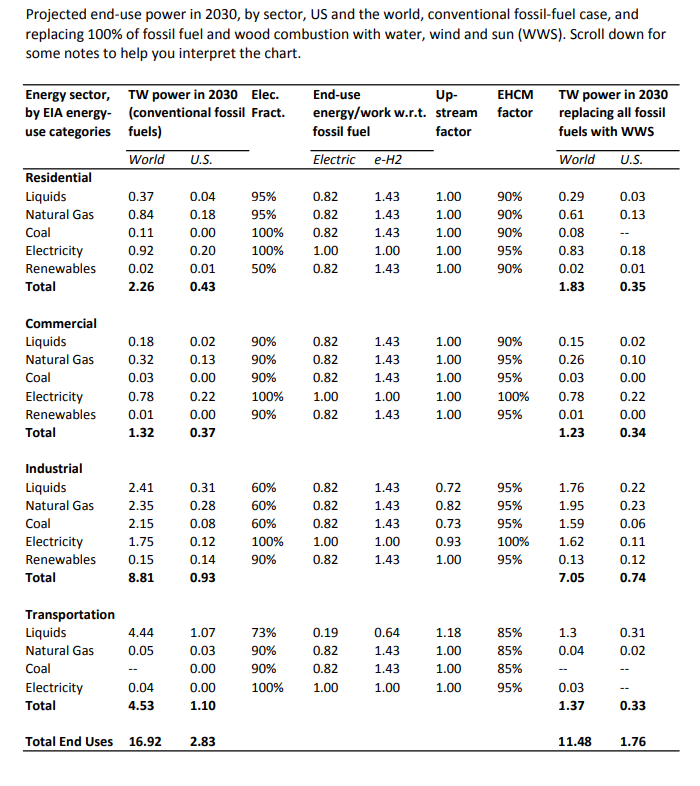

Projected end-use power in 2030, by sector, US and the world, conventional fossil-fuel case, and replacing 100% of fossil fuel and wood combustion with water, wind and sun (ww.). Scroll down for some notes to help you interpret the chart. EHCM factor End-use Up- energy/work w.r.t. stream fossil fuel factor Electric e-H2 TW power in 2030 replacing all fossil fuels with wws World U.S. Energy sector, TW power in 2030 Elec. by EIA energy- (conventional fossil Fract. use categories fuels) World U.S. Residential Liquids 0.37 0.04 95% Natural Gas 0.84 0.18 95% Coal 0.11 0.00 100% Electricity 0.92 0.20 100% Renewables 0.02 0.01 50% Total 2.26 0.43 0.03 0.13 0.82 0.82 0.82 1.00 0.82 1.43 1.43 1.43 1.00 1.43 1.00 1.00 1.00 1.00 1.00 90% 90% 90% 95% 90% 0.29 0.61 0.08 0.83 0.02 1.83 0.18 0.01 0.35 Commercial Liquids Natural Gas Coal Electricity Renewables Total 0.18 0.32 0.03 0.78 0.01 1.32 0.02 0.13 0.00 0.22 0.00 0.37 90% 90% 90% 100% 90% 0.82 0.82 0.82 1.00 0.82 1.43 1.43 1.43 1.00 1.43 1.00 1.00 1.00 1.00 1.00 90% 95% 95% 100% 95% 0.15 0.26 0.03 0.78 0.01 1.23 0.02 0.10 0.00 0.22 0.00 0.34 0.22 Industrial Liquids Natural Gas Coal Electricity Renewables Total 2.41 2.35 2.15 1.75 0.15 8.81 0.31 0.28 0.08 0.12 0.14 0.93 60% 60% 60% 100% 90% 0.82 0.82 0.82 1.00 0.82 1.43 1.43 1.43 1.00 1.43 0.72 0.82 0.73 0.93 1.00 95% 95% 95% 100% 95% 1.76 1.95 1.59 1.62 0.13 7.05 0.23 0.06 0.11 0.12 0.74 4.44 0.05 1.3 0.04 Transportation Liquids Natural Gas Coal Electricity Total 0.31 0.02 1.07 0.03 0.00 0.00 1.10 73% 90% 90% 100% 0.64 1.43 1.43 0.19 0.82 0.82 1.00 1.18 1.00 1.00 1.00 85% 85% 85% 95% 1.00 0.04 4.53 0.03 1.37 0.33 Total End Uses 16.92 2.83 11.48 1.76 QUESTION 1 The questions in this lab are kurgely based on a study by Jacobson & Delucci (Providing all global energy with wind, water, and solar power, Purt : Technologies, energy resources, qualities and creas of infrastructure, and materials) published in the Journal of Energy Policy. The data required to answer questions are reproduced here but it may be helptul to refer to the article for clarification You can download the article by clicking here Jacobann 2010 - Energy Policy.pdf Questions 1-6 are based on a table of projected energy use in 2030, which you can download by clicking here: Assignment 8 - Tableed Question 1: Which global sector USAs the most energy? Residential Transportation Industrial Commercial QUESTION 2 In the sector you chose for Question 1. how much could the U.S. reduce energy consumption by transitioning to a wind water, and solar (WWS) world? O 0.77 TW O 008 TW O 0.19 TW 176 TW QUESTION 3 Calculate the energy savings in a WWS world for each sector, globally and in the U.S. Fil your answer into the blank in the table below. Please give your answers rounded to the 2 digits after the decimal point. Global U.S. In TW 96 in TW 0.08 0.43 19.03% 18.60% Residential Commercial Industrial Transportation Total End Uses 5.44 32.15% 1.07 37.16% The Residential sector and Total End Uses are cakulated for you as an example HINT. To calculate the row number, subtract the "TW power in 2030 replacing alles with Wws from the "7W power in 2030 (conventionel fossivel)." To calculate the percentage, divide your TW savings by the "TW power in 2013 (conventional rosal felaj" number QUESTION 4 Based on your calculations in Question 3 which global sector will save the most energy by transitioning to WWS world? Industrial Transportation Commercial Residential Projected end-use power in 2030, by sector, US and the world, conventional fossil-fuel case, and replacing 100% of fossil fuel and wood combustion with water, wind and sun (ww.). Scroll down for some notes to help you interpret the chart. EHCM factor End-use Up- energy/work w.r.t. stream fossil fuel factor Electric e-H2 TW power in 2030 replacing all fossil fuels with wws World U.S. Energy sector, TW power in 2030 Elec. by EIA energy- (conventional fossil Fract. use categories fuels) World U.S. Residential Liquids 0.37 0.04 95% Natural Gas 0.84 0.18 95% Coal 0.11 0.00 100% Electricity 0.92 0.20 100% Renewables 0.02 0.01 50% Total 2.26 0.43 0.03 0.13 0.82 0.82 0.82 1.00 0.82 1.43 1.43 1.43 1.00 1.43 1.00 1.00 1.00 1.00 1.00 90% 90% 90% 95% 90% 0.29 0.61 0.08 0.83 0.02 1.83 0.18 0.01 0.35 Commercial Liquids Natural Gas Coal Electricity Renewables Total 0.18 0.32 0.03 0.78 0.01 1.32 0.02 0.13 0.00 0.22 0.00 0.37 90% 90% 90% 100% 90% 0.82 0.82 0.82 1.00 0.82 1.43 1.43 1.43 1.00 1.43 1.00 1.00 1.00 1.00 1.00 90% 95% 95% 100% 95% 0.15 0.26 0.03 0.78 0.01 1.23 0.02 0.10 0.00 0.22 0.00 0.34 0.22 Industrial Liquids Natural Gas Coal Electricity Renewables Total 2.41 2.35 2.15 1.75 0.15 8.81 0.31 0.28 0.08 0.12 0.14 0.93 60% 60% 60% 100% 90% 0.82 0.82 0.82 1.00 0.82 1.43 1.43 1.43 1.00 1.43 0.72 0.82 0.73 0.93 1.00 95% 95% 95% 100% 95% 1.76 1.95 1.59 1.62 0.13 7.05 0.23 0.06 0.11 0.12 0.74 4.44 0.05 1.3 0.04 Transportation Liquids Natural Gas Coal Electricity Total 0.31 0.02 1.07 0.03 0.00 0.00 1.10 73% 90% 90% 100% 0.64 1.43 1.43 0.19 0.82 0.82 1.00 1.18 1.00 1.00 1.00 85% 85% 85% 95% 1.00 0.04 4.53 0.03 1.37 0.33 Total End Uses 16.92 2.83 11.48 1.76 QUESTION 1 The questions in this lab are kurgely based on a study by Jacobson & Delucci (Providing all global energy with wind, water, and solar power, Purt : Technologies, energy resources, qualities and creas of infrastructure, and materials) published in the Journal of Energy Policy. The data required to answer questions are reproduced here but it may be helptul to refer to the article for clarification You can download the article by clicking here Jacobann 2010 - Energy Policy.pdf Questions 1-6 are based on a table of projected energy use in 2030, which you can download by clicking here: Assignment 8 - Tableed Question 1: Which global sector USAs the most energy? Residential Transportation Industrial Commercial QUESTION 2 In the sector you chose for Question 1. how much could the U.S. reduce energy consumption by transitioning to a wind water, and solar (WWS) world? O 0.77 TW O 008 TW O 0.19 TW 176 TW QUESTION 3 Calculate the energy savings in a WWS world for each sector, globally and in the U.S. Fil your answer into the blank in the table below. Please give your answers rounded to the 2 digits after the decimal point. Global U.S. In TW 96 in TW 0.08 0.43 19.03% 18.60% Residential Commercial Industrial Transportation Total End Uses 5.44 32.15% 1.07 37.16% The Residential sector and Total End Uses are cakulated for you as an example HINT. To calculate the row number, subtract the "TW power in 2030 replacing alles with Wws from the "7W power in 2030 (conventionel fossivel)." To calculate the percentage, divide your TW savings by the "TW power in 2013 (conventional rosal felaj" number QUESTION 4 Based on your calculations in Question 3 which global sector will save the most energy by transitioning to WWS world? Industrial Transportation Commercial Residential








